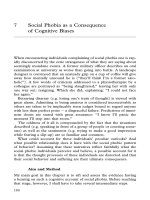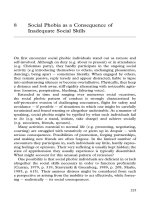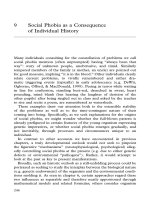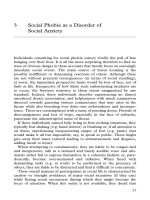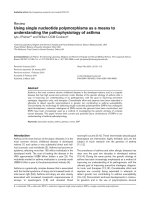Paraoxonase (PON1) polymorphisms as a biomarker of susceptibility to organophosphate toxicity among a cohort of singaporean workers
Bạn đang xem bản rút gọn của tài liệu. Xem và tải ngay bản đầy đủ của tài liệu tại đây (4.06 MB, 130 trang )
PARAOXONASE (PON1) POLYMORPHISMS AS A
BIOMARKER OF SUSCEPTIBILITY TO
ORGANOPHOSPHATE TOXICITY AMONG A COHORT
OF SINGAPOREAN WORKERS
SAFIYYA MOHAMED ALI
B.Sc. Life Sciences (Hons.), NUS
A THESIS SUBMITTED
FOR THE DEGREE OF MASTER OF SCIENCE
DEPARTMENT OF COMMUNITY, OCCUPATIONAL AND
FAMILY MEDICINE
NATIONAL UNIVERSITY OF SINGAPORE
2009
ACKNOWLEDGEMENTS
I would like to express my utmost gratitude to my supervisor Professor Chia
Sin Eng who proposed PON1 for me as a subject of this Masters thesis. During my
experience as a Research Assistant and a Masters student in the Department of
Community, Occupational and Family Medicine (COFM), Yong Loo Lin School of
Medicine, National University of Singapore, Prof Chia has introduced me to the world
of occupational health, neurotoxicity, statistics and epidemiology. Prof Chia has not
only been an invaluable guiding and motivational source in my academic pursuit, but
also an important source of support for my personal development. His kindness and
dedication to his career as an occupational health physician and a researcher have
inspired me greatly in the field of public health.
I express my thanks to Professor Chia Kee Seng from the Centre of Molecular
Epidemiology, NUS, for organising the courses under the NUS-KI Joint PhD
programme in Genetic and Molecular Epidemiology (GAME) and giving me the
opportunity to attend the modules that were conducted in Sweden. He has also given
constructive criticism of the project which helped me to look into various angles of
the analysis.
Special acknowledgements to him and Dr Teo Yik Ying of the
Singapore Genome Variation Project for early access to unpublished data on the allele
frequency of rs662 (PON1Q192R) across the three ethnic groups in Singapore, and
more specifically to Miss Sim Xueling for her help in extracting this data.
I am grateful to our collaborator Professor Eric Yap Peng Huat for giving me
access to carry out genotyping work at the Defence Medical and Environmental
Research Institute laboratory, Defence Science Organisation, Singapore. This portion
of the project would not have been possible without the help of Ms Rachel Tham, Ms
Linda Gan and Mr Yim Onn Siong who lent me their expert knowledge in the area.
i
I am thankful to my co-workers namely Mr Ong Her Yam, Mr Ong Yeong
Bing, Mr Andrew Wee, Ms Vivian Ng, Ms Chua Lay Ha, Ms Amy Chan and Ms Julie
Chew. They were involved in the field trips for the medical surveillance of all the
workers and were responsible for the collection of the study materials. I also deeply
appreciate the technical help from Mr Ong Yeong Bing for brainstorming and
optimising enzymatic assays with me. He has always been ready to lend a hand
whenever I needed help in the laboratory.
My sincere thanks are due to Ms Lim Gek Hsiang for her assistance and
advice in the statistical analysis of this thesis and of our published original article.
The numerous scientific and less scientific discussions with her have created a
pleasant working atmosphere and a wonderful friendship.
Warm thanks go to my parents, sister, and the rest of my family for their
understanding, support and comfort not only during this project, but throughout my
previous studies. I would like to dedicate this thesis to my dear fiancé Farooq; his
love and support has kept me going especially on days where everything seemed to be
going wrong. Because of him, I had the strength and motivation to complete this
thesis. Finally and most importantly, all praises be to God who granted me the
opportunity and strength to undertake my Masters studies.
We would like to thank the men who have participated in the study. This
study was supported in part by a grant from the National Medical Research Council,
NMRC/EDG/0008/2007 and the Life Sciences Institute, National University of
Singapore, R-329-000-008-712.
ii
PUBLICATIONS
Papers published and accepted for publication in international journals
1. Chia Sin Eng, Safiyya Mohamed Ali, Yap Peng Huat Eric, Linda Gan, Ong
Yeong Bing, Chia Kee Seng. Distribution of PON1 polymorphisms –
PON1Q192R and PON1L55M among Chinese, Malay and Indian males in
Singapore
and
possible
susceptibility
to
organophosphate
exposure.
Neurotoxicology 2009. (Accepted for publication)
2. Safiyya Mohamed Ali and Sin Eng Chia. Interethnic variability of plasma
paraoxonase
(PON1)
activity
towards
organophosphates
and
PON1
polymorphisms among Asian populations – A Short Review. Industrial Health
2008; 46(4):309.
Papers presented at international meetings
1. Safiyya Mohamed Ali, Sin Eng Chia. Association between cholinesterase Activity
and human paraoxonase (PON1) polymorphisms in workers exposed to
organophosphates. HUGO 13th Human Genome Meeting (HGM2008), 27-30
September 2008, Hyderabad, India.
2. Sin Eng Chia, Safiyya Mohamed Ali, Yeong Bing Ong. Paraoxonase (PON1)
activities and genotype distribution among Chinese, Malay and Indian workers in
Singapore. 20th International Conference on Epidemiology in Occupational
Health (EPICOH-NEUREOH 2008), 9-11 June 2008, Heredia, Costa Rica.
iii
3. Safiyya Mohamed Ali, Sin Eng Chia. Interethnic variability of plasma
paraoxonase (PON1) activity and PON1 polymorphisms among Asian
populations. The 5th Princess Chulabhorn International Science Congress (PCVI), Chulabhorn Research Institute, 25-29 November 2007, Bangkok, Thailand.
4. Sin Eng Chia, Safiyya Mohamed Ali. Association of RBC and serum
cholinesterase levels among organophosphate exposed pesticide workers and noexposed workers in Singapore. The 5th Princess Chulabhorn International Science
Congress (PC-VI), Chulabhorn Research Institute, 25-29 November 2007,
Bangkok, Thailand.
iv
TABLE OF CONTENTS
SUMMARY .............................................................................................................. viii
LIST OF TABLES .......................................................................................................x
LIST OF FIGURES .....................................................................................................x
INTRODUCTION........................................................................................................1
LITERATURE REVIEW ...........................................................................................4
Organophosphates .......................................................................................................4
Structure and properties of organophosphates..........................................................4
Applications of organophosphates.............................................................................5
Organophosphate toxicity..........................................................................................6
Cholinesterase and organophosphate toxicity...........................................................9
Paraoxonase-1 (PON1) Protein.................................................................................11
Introduction to the PON1 protein ............................................................................11
Synthesis and structure ............................................................................................13
Measurement of activity...........................................................................................14
Measurement of concentration ................................................................................17
Role of PON1 in detoxifying organophosphates......................................................17
PON1 Gene .................................................................................................................20
PON gene family and structure of PON1 ................................................................20
PON1 polymorphisms ..............................................................................................21
Coding region polymorphisms: Q192R and L55M..................................................22
Promoter region polymorphisms .............................................................................24
PON1 haplotypes .....................................................................................................24
PON1 polymorphisms and ethnic distribution.........................................................25
PON1 and Organophosphate Toxicity.....................................................................28
PON1 levels and polymorphisms .............................................................................28
Environmental factors affecting PON1 concentration and activity.........................30
v
AIMS OF THE STUDY.............................................................................................33
PARTICIPANTS AND METHODS ........................................................................35
Study Population........................................................................................................35
Laboratory Methods..................................................................................................36
Blood sampling ........................................................................................................36
Cholinesterase measurements..................................................................................37
PON1 activity measurements...................................................................................37
PON1 polymorphism screening ...............................................................................38
Statistical methods ...................................................................................................40
RESULTS ...................................................................................................................42
Descriptive Characteristics of the Study Population..............................................42
Cholinesterase Measurements ..................................................................................46
Cholinesterase levels between exposure groups......................................................46
Cholinesterase levels between ethnicities................................................................46
Cholinesterase levels between groups, stratified by ethnicity .................................47
Predictors of cholinesterase levels ..........................................................................47
PON1 (Paraoxonase/Diazoxonase) Activity.............................................................48
PON1 activity between exposure groups .................................................................48
PON1 activity between ethnicities ...........................................................................48
PON1 activity between exposure groups, stratified by ethnicity .............................49
PON1 Genotypic Distribution...................................................................................50
PON1 genotypic distribution by exposure groups ...................................................50
PON1 genotypic distribution by ethnicities .............................................................51
PON1 alleles ............................................................................................................52
PON1 genotypic distribution by exposure groups, stratified by ethnicity ...............53
PON1 genotype and PON1 activity .........................................................................54
PON1 Status ...............................................................................................................55
vi
PON1 Genotypes and Cholinesterase Levels...........................................................56
Factors affecting PON1 activity................................................................................57
DISCUSSION .............................................................................................................58
Study Participants......................................................................................................58
Methodological Considerations ................................................................................60
Cross-sectional study ...............................................................................................60
Questionnaire...........................................................................................................60
Laboratory Methods.................................................................................................62
Cholinesterase Measurements ..................................................................................64
PON1 Activity, Status and Genotype .......................................................................67
Recommendations Arising from the Study..............................................................71
Future Prospects ........................................................................................................72
SUMMARY AND CONCLUSIONS ........................................................................75
BIBLIOGRAPHY ......................................................................................................78
APPENDICES ............................................................................................................94
Appendix I ..................................................................................................................95
Appendix II...............................................................................................................103
Appendix III .............................................................................................................113
vii
SUMMARY
Organophosphate (OP)-containing pesticides are extensively used worldwide for
domestic and industrial purposes. Studies on acute and chronic exposure to OPs have
revealed numerous health effects attributed mainly to acetylcholinesterase inhibition.
The enzyme human serum paraoxonase (PON1) is involved in the detoxification of
OP compounds. PON1 polymorphisms have been shown to affect susceptibility to
OP exposure. In this study, we investigated the effect of OP exposure on pest control
workers using cholinesterase levels as biomarkers of toxicity. Next we determined
PON1 activity towards two OP substrates (paraoxon and diazoxon) of our sample as
well as the distribution of two common PON1 polymorphisms in our local population
(PON1Q192R and PON1L55M) and assessed whether these factors were involved in
OP toxicity.
The exposed group consisted of 103 workers from various pest control companies
under the Singapore Pest Management Association while the 91 unexposed workers
were from a lead stabiliser factory. For all workers, the mean age was 36.9 (20–70)
years and the ethnic distribution was 38.1% Chinese, 44.3% Malay and 17.5% Indian.
The mean ± SD exposure duration among the pesticide workers was 10.4 ± 8.4 years.
The mean ± SD erythrocyte cholinesterase level was 18436.2 ± 2078 U/L and 18079.6
± 1576 U/L for the exposed and unexposed groups respectively (p=0.216). The mean
± SD serum pseudocholinesterase level was 11028.4 ± 2867.4 U/L and 9433.6 ±
2022.6 U/L in the exposed and unexposed groups respectively (p<0.0001). The mean
± SD paraoxonase levels in the exposed and unexposed groups were 299.4 ± 135.0
U/L and 178.2 ± 58.1 U/L respectively (p<0.0001). The mean ± SD diazoxonase
levels in the exposed and unexposed groups were 1525.6 ± 635.0 U/L and 1929.3 ±
viii
905.7 U/L respectively (p=0.0007). Mean paraoxonase activity was similar among
Chinese and Malays (266.5 U/L and 266.3 U/L respectively) whereas that of the
Indians was significantly lower (165.6 U/L). The R and L allele, which confer higher
PON1 activity and higher PON1 levels respectively, were found in higher frequencies
in Malays and Chinese compared to Indians.
Our study showed that cholinesterase levels among the exposed were not lower than
those in the unexposed group.
PON1 activity and consequently PON1
polymorphisms differed among ethnic groups, implying that ethnicity could be an
important surrogate for identifying susceptible groups in case of OP exposure.
Although OP poisoning is rare among occupationally exposed workers in Singapore,
this information would be useful for other developing countries that have large
populations of Chinese, Malays and Indians where OP exposure could be very high
especially in agricultural settings.
ix
LIST OF TABLES
Table 1. General characteristics of the study population.
Table 2. Commonly used pesticides among exposed workers in Singapore.
Table 3. Serum PChE and RBC AChE levels for each exposure group by ethnicity.
Table 4. Correlation results of independent variables and serum PChE.
Table 5. POX and DZO levels for each exposure group by ethnicity.
Table 6. Distribution of PON1Q192R and PON1L55M genotypes.
Table 7. Allelic frequencies of both PON1 polymorphisms by ethnicity.
Table 8. Ethnic distribution of genotypes by exposure group.
Table 9. PON1 activity by PON1Q192R and PON1L55M genotypes.
Table 10. Serum PChE and RBC AChE levels by PON1 genotypes.
LIST OF FIGURES
Figure 1. General structure of OP compounds.
Figure 2. Biodegradation of OP compounds – parathion, chlorpyrifos, diazinon, sarin
and soman by PON1.
Figure 3. The cholinergic mechanism at synapses.
Figure 4. Overall structure of PON1.
Figure 5. Determination of PON1 status.
Figure 6. PON gene structure.
Figure 7. Restriction enzyme analysis of the PON1 Q192R (top) and L55M (bottom)
genotypes.
Figure 8. Genotyping of PON1Q192R and PON1L55M polymorphisms.
Figure 9. Plot of DZO vs. POX activity of the whole study sample.
x
INTRODUCTION
Organophosphates (OPs) are esters of phosphoric acid produced by the reaction of
alcohols and phosphoric acid. OPs are widely used as insecticides worldwide and
they are readily available commercially for domestic and industrial purposes. In
addition, OPs are also utilised as therapeutic agents in the treatment of ophthalmic
conditions (e.g. echothiophate, isoflurophate) (Lloyd 1963) and as antihelmintics
(trichlorfon) (Harder 2002), as well as nerve agents in chemical warfare (e.g. sarin,
soman) (Holstege et al. 1997). Bioactivation of OP compounds converts them from
their relatively non-toxic form into very highly toxic oxon forms. In this form, they
are very strong cholinesterase inhibitors and cause toxicity through cholinesterase
inhibition.
OPs are widely used in agriculture as insecticides and herbicides as they are readily
available commercially for domestic and industrial purposes. This is especially true
in developing countries where they are more affordable than newer options. Even in a
developed country like Singapore where different kinds of pesticides are highly
accessible, OPs are still being used in the pest management industry. Therein exists
the problem of pesticide poisoning because of its wide usage. The World Health
Organisation (WHO) estimated that acute pesticide poisoning affects as many as 39
million people around the world (WHO/United Nations Environment Programme
1990). Despite this shocking figure, there is presently no global system to track
poisonings or diseases closely related to pesticide use. WHO also estimated that two
million cases and 220000 deaths occur due to acute pesticide poisonings worldwide.
These account for only a tiny fraction of the actual number of cases because these
estimates are based on government records of pesticide-related hospitalisations while
1
the vast majority of acute pesticide-related illnesses do not result in hospitalisation or
may not have been reported. Although research documenting detrimental health
effects of OP exposure has prompted many western countries to ban OP usage, OP
pesticides are still being widely used in Asia (Pesticide Action Network UK 1993). A
survey conducted in Asian countries estimated that on average, 3% of agricultural
workers in developing countries suffer an episode of pesticide poisoning a year
(WHO/United Nations Environment Programme 1990).
In addition to OPs being a health hazard in agriculture, there is increasing worry about
the adoption of such chemicals in terrorism and chemical warfare. In 1994, civilians
in Matsumoto, Japan were attacked with sarin gas, resulting in the deaths of seven
people and almost 200 persons needing medical attention (Morita et al. 1995). This
preceded another unfortunate incident in Tokyo in 1995 whereby sarin was released in
subways, killing 10 people while injuring over 5000 (Suzuki et al. 1995). These
chemical warfare agents have also been exploited as weapons of mass destruction and
have caused, for instance, suspected accidental exposure to military personnel during
the Gulf War resulting in many Gulf War veterans still suffering from OP poisoning
effects today (McCauley et al. 2001).
What is the situation like in Singapore? Here, pesticide usage is tightly regulated.
Under the Control of Vectors and Pesticides Act 1998, all public health pesticide
products and repellents intended for use against the five vectors (i.e. mosquitoes, flies,
cockroaches, rodents and rat fleas) in Singapore are required to be registered by the
National Environment Agency (NEA) of Singapore prior to local sale (National
Environmental Agency 2004).
OP pesticides (i.e. pesticides containing an
2
organophosphorous group, an organochlorine group or a carbamate group) are
controlled under the Environmental Pollution Control Act 1999 and require the
Poisons Licence and Permit. They are also required to be registered as long as they
are used against the five vectors stated above. Apart from the tight regulations above,
workers handling pesticides are also required to undergo health surveillance every six
months to monitor their cholinesterase levels.
While these measures are in place, to date, there have been no known reported studies
on pesticide exposure in Singapore. An investigation into the exposure levels, using
cholinesterase levels as biomarkers of OP toxicity, among our pesticide workers
would give an important insight onto whether these regulatory measures are effective.
As an extension to this, it would be interesting to find out the different factors that
might affect susceptibility to OP toxicity namely paraoxonase-1 (PON1) levels, which
is the main enzyme involved in detoxification of OP compounds. As paraoxonase
levels are governed by genetic polymorphisms in the PON1 gene, we also sought to
study the effect of this on PON1 and cholinesterase levels. These in turn are affected
by ethnicity, hence, our population being multi-ethnic, enabled us to look into these
differences. With these pointers in mind, we carried out the following study with the
hope of studying the exposure status of pesticide workers in Singapore while at the
same time establishing the phenotypic and genotypic characteristics of PON1 in the
Indians, Malays and Chinese here.
3
LITERATURE REVIEW
Organophosphates
Structure and properties of organophosphates
OPs are produced by the reaction of alcohols and phosphoric acid to make esters of
phosphoric acid. They are made up of a structure consisting of a phosphorous atom
linked to a sulphur or oxygen atom via a double bond (Figure 1). The phosphorus
atom is esterified by two alkyl chains and the remaining bond contains a chemical
moiety that differs widely among different types of OPs. This leaving group could be
an alkyl, alkoxy, alkylthio, aryl or heterocyclic, aryloxy or a heterocyclic analog.
Figure 1. General structure of OP compounds. R= methyl, ethyl or isopropyl. X= Leaving
group.
Three commonly used organophosphorous insecticides – parathion, diazinon and
chlorpyrifos, contain a sulphur atom attached to the phosphorus atom.
In their
original form, these molecules are relatively non-toxic. However, bioactivation by
cytochrome P450 enzymes (including CYP 3A4) (Sams et al. 2000) convert them to
very highly toxic oxon forms (i.e. paraoxon, diazoxon and chlorpyrifos-oxon
respectively). This bioactivation involves the removal of the sulphur atom and
replacement with an oxygen atom.
The oxon forms are strong cholinesterase
inhibitors and cause death through cholinesterase inhibition. Detoxification of these
toxic oxon forms occur through the same cytochrome P450 enzymes involved in their
4
bioactivation, and also through conjugation with glutathione and hydrolysis by
esterases found in many mammalian species e.g. carboxylesterase and PON1. The
nerve agents sarin and soman do not require bioactivation and can be hydrolysed
directly by PON1.
Figure 2 shows the chemical pathways of activation and
detoxification of these compounds.
O
S
(H 2 O )
(O )
(EtO ) 2 PO
NO2
(EtO ) 2 PO
m icrosom al
oxidation
Parathion
Cl
Cl
(O )
(EtO ) 2 PO
N
Cl
C hlorpyrifos
m icrosom al (EtO ) PO
2
oxidation
(EtO ) 2 PO
N
D iazinon
D iethyl
phosphate
3,5,6-T richloro-2pyridinol
CH3
N
N
O
CH3
P
P
H C (C H 3 ) 2
D iethyl
Phosphoric
Acid
IM H P
O
H
O
HO
O C2H5
N
O
H
O C2H5
+
N
plasm a
paraoxonase
HO
H C (C H 3 ) 2
D iazoxon
CH3
(EtO ) 2 PO 2 -
+
Cl
(H 2 O )
O
m icrosom al
oxidation
(EtO ) 2 PO
H C (C H 3 ) 2
D iethyl
phosphate
Cl
Cl
plasm a
OH
paraoxonase
Cl
N
(EtO ) 2 PO 2 -
+
p-N itrophenol
CH3
(O )
N
(H 2 O )
C hlorpyrifos oxon
CH3
S
Cl
O
NO2
HO
plasm a
paraoxonase
Paraoxon
Cl
S
NO2
F
CH3
O
CH3
CH3
O
CH3 H
P
OH
F -
+
CH3
Sarin
CH3 H
CH3
O
CH3 CH3
P
CH3
F
O
O
CH3
CH3 CH3
P
OH
+
F -
CH3
S om an
Figure 2. Biodegradation of OP compounds – parathion, chlorpyrifos, diazinon,
sarin and soman by PON1. (Adapted from Davies et al. 1996)
Applications of organophosphates
OPs are largely used in agriculture as insecticides and herbicides. They are readily
available commercially for domestic and industrial purposes. OPs are the most
commonly used group of insecticides worth nearly 40% of the global market
(Pesticide Action Network UK 1996). OPs are widely used in developing countries as
they are more affordable than newer and safer alternatives. Even in Singapore, where
5
there is high accessibility to different kinds of pesticides, OPs are still being used in
the pest management industry.
OPs are used widely as solvents, plasticisers and extreme pressure (EP) additives
(Thomas and Macaskie 1996; Carlsson et al. 1997). In addition, OPs are also utilised
as therapeutic agents in the treatment of ophthalmic conditions (e.g. echothiophate,
isoflurophate) (Lloyd 1963), as antihelmintics (trichlorfon) (Harder 2002), and even
in the treatment of Alzheimer’s disease (Imbimbo 2001). OPs have also been used as
nerve agents in chemical warfare (e.g. sarin, soman) (Holstege et al. 1997).
Organophosphate toxicity
OPs exert their toxicity by inhibiting the enzyme acetylcholinesterase (AChE) in the
nervous system. This enzyme catalyses the hydrolysis of acetylcholine, a major
neurotransmitter in the central and peripheral nervous system, into choline and acetic
acid. When AChE is inactivated by phosphorylation of the serine hydroxyl group at
the active site of AChE, acetylcholine released from nerve terminals accumulates and
over-stimulation of muscarinic and nicotinic receptors occurs (Ecobichon 2001). OPs
can be ingested, inhaled, absorbed through the skin or injected. The schematic in
Figure 3 depicts what happens during AChE inactivation at nerve terminals (Adapted
from Pope et al. 2005).
6
Figure 3. The cholinergic mechanism at synapses. Usually, acetylcholine (ACh) released
by the presynaptic terminal is hydrolysed by AChE. Choline is released and transported back into the
presynaptic terminal by the high affinity choline uptake (HACU) process. Choline acetyltransferase
(ChAT) forms acetylcholine using choline and acetyl coenzyme A. Synaptic vesicles fuse with the
plasma membrane and release acetylcholine into the cleft upon terminal depolarisation. When enough
cholinesterase inhibitors bind to AChE to (1) block transmitter degradation, acetylcholine accumulates
in the synaptic cleft (2). This results in constant stimulation of cholinergic receptors on the
postsynaptic cell (3). Excessive activation of these postsynaptic receptors results in prolonged receptor
signalling (4) and related changes in postsynaptic cell function.
The clinical features of OP poisoning manifest in the form of a cholinergic crisis. The
onset of symptoms occurs within hours of exposure and this may include collapse,
sweating, breathing problems, excessive salivation, diarrhoea, vomiting, heart
dysrrthymias and extreme anxiety. Cardiac or respiratory failure may lead to death.
The onset and severity of symptoms is dependent on the type of OP, amount, route of
exposure and rate of metabolic degradation. In mild cases, symptoms are usually
treated with oximes (e.g. pralidoxime chloride) which reactivate phosphorylated
AChE.
Treatment may be augmented with atropine which is an acetylcholine
7
antagonist that prevents the action of acetylcholine on muscarinic receptors (Namba et
al. 1971). Supplementary pharmacological treatment with diazepam and supportive
treatment through artificial ventilation may be employed in cases of severe poisoning
(Lotti 2001).
Several OPs are capable of causing organophosphate-induced delayed polyneuropathy
(OPIDP). This happens when neurons are killed due to acute or chronic OP poisoning
and its onset is usually a few days up to two-three weeks after poisoning. Signs and
symptoms include sharp, cramp-like pains in the calves, tingling of the hands and feet,
followed by distal numbness and parathesia. The molecular target for OPIDP is
neuropathy target esterase (NTE), which has esteratic activity towards phenyl
phenylacetate, phenylvalerate or closely related esters. Although there may be some
functional recovery, motor neurons may permanently lose function (Jokanovic et al.
2002).
In addition to the neurotoxic effects stated above, OPs have also been implicated in
developmental (neuro)toxicity. Experimental data has shown that young animals are
more sensitive to the effects of exposure owing to their lower metabolic capabilities
(Pope and Liu 1997; Vidair 2004). The mechanisms suggested for these effects
include inhibition of brain AChE, downregulation of muscarinic receptors, decreased
brain DNA synthesis and reduced brain weight in offspring. Young children are also
expected to be more sensitive to acute toxicity than adults through extrapolation of
animal data. Indeed it has been shown that levels of chlorpyrifos in umbilical cord
plasma of mothers exposed to pesticides were inversely associated with birth weight
and length (Whyatt et al. 2004). The routes of exposure in children are similar to
8
adults but due to children’s hand-to-mouth behaviour, breastfeeding from exposed
mothers and increased time spent outdoors, their likelihood of exposure is greater than
adults. Parental exposure to pesticides or application of pesticides in the home has
been linked to respiratory health effects, childhood brain tumours, leukemias and
lymphomas, testicular and other cancers, and neural tube and other birth defects
(Buckley et al. 1989; Blair et al. 1992; Kristensen et al. 1996; Blatter et al. 1997).
Toxicity to OPs may be significantly affected by genetic differences in the enzymes
involved in the bioactivation and detoxification of OPs, as well as the enzymes
targeted by these compounds (Costa 2001). The focus of this project is on PON1 but
polymorphisms in cytochromes P450 (CYP), glutathione-S-transferases (GST) as well
as of erythrocyte acetylcholinesterase (RBC AChE) and serum pseudocholinesterase
(serum PChE) [the latter two discussed below] may also be players in OP toxicity,
although there is little convincing evidence that proves so to date.
Cholinesterase and organophosphate toxicity
As mentioned above, the primary target for OP toxicity is AChE. The discovery that
OPs inhibited AChE was the basis of development of OPs as pesticides, since the
insect and mammalian cholinergic nervous systems are highly similar. OP toxicity is
clinically diagnosed through measurement of cholinesterase activity. RBC AChE and
serum PChE may both be used. However, RBC AChE is a better indicator of CNS
cholinesterase because RBC AChE concentrations are presumed to closely reflect the
effects of OP agents in target organs, if the OP has equal access to the synapses and
blood. Hence it is a more useful marker of OP poisoning than serum PChE. Because
of this, the measurement of both enzymes has been recommended in clinical
9
toxicology and monitoring of high-risk occupational activities (HSE 2000). Pesticide
over-exposure is indicated by a depression of at least 15% from an individual’s
normal level of serum or erythrocyte enzyme activity. There is large inter-individual
variability in cholinesterase levels hence it has been suggested that measuring an
individual’s cholinesterase level with reference to his baseline values (when not
exposed) would be more sensitive than comparing it to a ‘population normal average’.
However, in cases of severe OP exposure, the depression of both serum PChE and
RBC AChE would be certainly obvious and such measurements would generally not
be necessary.
RBC AChE is considered a marker of chronic exposure whereas serum PChE is more
suited for measuring acute toxicity. This is because while serum PChE recovers
quickly, within four weeks of OP exposure, RBC AChE takes a longer time
(recovering at a rate of ~1% per day) and may take as long as several months to be
restored to normal function. RBC AChE activity restoration takes place by some
spontaneous dephosphorylation of the inhibited enzyme and mainly by slow de novo
synthesis of fresh enzyme.
Inactivation (phosphorylation) and reactivation
(dephosphorylation) rates differ widely for various OP compounds, accounting for the
differing toxicity of the various OP agents. Since one radical is lost (ageing) during
enzyme inactivation thus making it more stable, spontaneous dephosphorylation does
not occur. In this way, there is a relationship between ageing and toxicity, with
certain agents like soman rapidly increasing ageing (Karalliedde 1999).
10
Paraoxonase-1 (PON1) Protein
Introduction to the PON1 protein
Human serum paraoxonase (PON1) is a member of the A-esterase family (EC 3.1.8.1)
that includes PON2 and PON3. Human PON2 and PON3 are similar to PON1 in that
they are able to hydrolyse aromatic and long-chain aliphatic lactones (Draganov et al.
2005). However, they are both distinct from PON1 due to their very limited ability to
hydrolyse
paraoxon.
As
such,
our
discussion
paraoxonase/diazoxonase capabilities of PON1 alone.
will
focus
on
the
PON1 derived its name
originally from its ability to hydrolyse paraoxon. It is a highly glycosylated protein
weighing about 44 kDa and consisting of 355 amino acids (Hassett et al. 1991).
Serum concentration of PON1 is about 50 mg/L (Haagen and Brock 1992). Early
studies measuring PON1 paraoxonase activity, using paraoxon as a single substrate, in
Caucasian subjects revealed a bimodal or trimodal distribution (Eckerson et al. 1983).
These enzymatic tests were able to divide serum PON1 activity into three phenotypes:
low, intermediate and high PON1 activity without a clear distinction between
intermediate and high metabolisers.
Although the physiological role of PON1 has not been established, serum PON1 has
been recognised to be involved in the detoxification of OP insecticides (reviewed in
Costa et al. 1999) and nerve agents (Smolen et al. 1991). It is closely associated with
the HDL complex (Blatter et al. 1993) and there is accumulating evidence of its role
in the prevention of LDL oxidation and atheroma formation (Mackness et al. 1993),
hence preventive roles in cardiovascular disease. PON1 degrades hydrogen peroxide
via its peroxidase activity, hydrolyses phospholipid hydroperoxides and cholesterol
ester hydroperoxides via its esterase activity and reduces lipid hydroperoxides to their
11
respective hydroxides (Aviram et al. 2000). PON1 also improves reverse cholesterol
transport to the liver and prevents HDL peroxidation (Aviram et al. 1998). It may
also have a role in protecting plasma membranes from free radical injury (Durrington
et al. 2001) and degrades bioactive phospholipids like platelet-activating factor (PAF)
(Rodrigo et al. 2001). More recently, it was discovered that PON1 has lactonase
activity and is involved in metabolism of drugs such as statins, spironolactone and
glucocorticoid lactones (Billecke et al. 2000).
It also hydrolyses homocysteine
thiolactone and prevents homocysteinylation of proteins, which is part of the
atherogenesis process (Jakubowski 2000).
PON1 is found in many animal species (La Du et al. 1993; La Du 1996; Nevin et al.
1996) except birds, fish and insects (Mackness et al. 1996). Earlier studies showed
that birds were more sensitive than rats to OP toxicity since they have no to very low
plasma PON1 activity (Brealey CB 1980). Interestingly, recent studies suggest that
birds have PON1-like genes which are about 70% identical to human PON1 (PrimoParmo et al. 1996). Despite this, they have very low paraoxonase/arylesterase activity
which is less than 1% of the average human levels. Rabbit and human sequence
comparisons show almost 85% similarity at both protein and DNA levels, indicating
the importance of the metabolic role of PON1. In humans, serum PON1 is present in
newborn and premature infants at half the level of that found in humans, but the levels
reach adult levels quickly in just about one year after birth (Zech and Zurcher 1974;
Mueller et al. 1983; Cole et al. 2003). Older studies have claimed that PON1 levels
are stable in adults and that there are no significant changes observed with age (Zech
and Zurcher 1974; Playfer et al. 1977; Mueller et al. 1983). However, newer ones
show that there is a progressive decline in PON1 activity in elderly people
12
(Milochevitch and Khalil 2001; Jarvik et al. 2002; Seres et al. 2004). PON1 is present
at basal levels in the body and levels may change under different circumstances. This
will be elaborated on in another section.
Synthesis and structure
PON1 is synthesised in the liver and some of it is secreted into the plasma where it
associates with high density lipoprotein particles (La Du et al. 1993). PON1 is also
distributed into different tissues such as the kidney, heart, brain, lungs and small
intestines (Primo-Parmo et al. 1996).
Human PON1 was purified in 1991 (Gan et al. 1991), allowing the elucidation of the
molecular mechanism of the PON1 activity polymorphism.
An interesting feature
about PON1 synthesis is that it retains its signal sequence and only the initiator
methionine is cleaved. The mature PON1 protein contains three cysteine residues;
two of which form a disulfide bridge (C42 and C353) (Sorenson et al. 1995). The
third (C284) plays a role in the hydrolysis of substrates such as lactones, and in the
prevention of low-density lipoprotein oxidation, but is not required in the hydrolysis
of other substrates such as phenylacetate and paraoxon (Aviram et al. 1998). PON1
has two Ca2+ binding sites; there are two Ca2+ ions present in the central tunnel of the
protein, one which acts as a stabiliser for the structure and the other which is involved
in catalysis. The former Ca2+ ion has a phosphate ion bound to it. PON1 also has two
N-linked glycosylation sites (Kuo and La Du 1995) and hydrophobic amino acid
residues at the amino terminal end of the protein. These residues account for its
tendency to bind to other proteins and aggregate by itself (La Du et al. 1993). There
are specific tryptophan, histidine, glutamic acid and aspartic acid residues that are
13
important components in the catalytic and calcium-binding sites of PON1 (Doorn et
al. 1999; Josse et al. 1999; Josse et al. 2001).
The recent elucidation of its crystal structure through a directly-evolved PON1
variant, together with directed evolution studies, has allowed the study of PON1’s
active site and its possible catalytic mechanisms (Harel et al. 2007). However, the
exact catalytic mechanism of OPs has not yet been discovered. Harel et al. (2007)
postulated that the lactonase and esterase functions of PONs are catalysed by a
His115-His134 dyad, and that paraoxonase activity is probably catalysed by different
residues. Figure 4 shows the crystallised structure of PON1.
Figure 4. Overall structure of PON1. (a) View of the crystallised structure of PON1 from
above. Harel et al. discovered that PON1 was made up of a six-bladed -propeller (A-D). The N and
C termini and the two calcium atoms in the central tunnel of the propeller (Ca1, green; Ca2, red) are
shown. (b) A side view of the propeller, including the three helices at the top of the propeller (H1−H3).
(Adapted from Harel et al. 2007)
Measurement of activity
PON1 activity can be measured using serum isolated from heparin-collected blood.
Measurements are carried out using a spectrophotometer or equivalent instrument.
14


